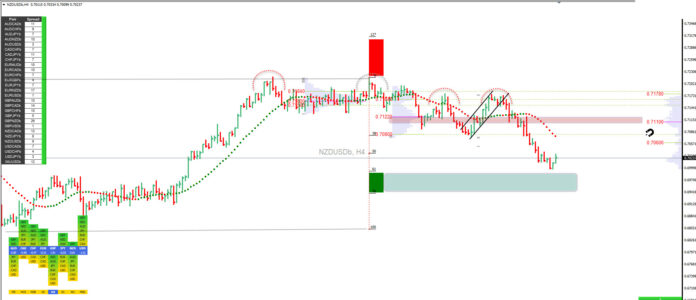- NZDUSD remains vulnerable as the downtrend has resumed amid a stronger Greenback.
- FOMC is looking to hike interest rates after more robust than expected US CPI figures were released.
- US Dollar is expected to maintain the bullish tone until the next Fed meeting.
- Technically, the NZDUSD pair seems poised to break the support levels and finally test the 0.6870 area.
The NZDUSD pair has resumed a series of lower highs and lows since the beginning of this week after reversing the initial response to a stronger-than-expected rise in the US consumer price index (CPI). It seems that the the persistence of higher inflation boosted the value of the US dollar even more, adding further pressure to the Federal Reserve System to push through higher interest rates sooner rather than later.
The Federal Reserve’s Open Markets Committee (FOMC) is still debating how it will respond to the new print dates since San Francisco President Mary Daley, a voting member of 2021, argues that the switch would be premature.
“Uncertainty requires us to wait and watch closely,” a government official said in an interview with Bloomberg News.
The FOMC will stick to its exit strategy as it prepares for a temporary surge in inflation. Still, signs of stronger price surges could push the US Dollar higher before the next FOMC rate decision on Dec 15, when the central bank plans to update its summary of economic projections (SEP).
On the other hand, the RBNZ’s inflation expectation data will be released on Nov 16. Market participants anticipate the inflation expectations at 2.27%. Any print higher than the expected value may trigger some support for the Kiwi. This is an important indicator to gauge the economic recovery after Covid and may signal a rate hike.
The NZDUSD exchange rate could continue to depreciate until then, as it has failed to test the October high (0.7219), and further depreciation in the exchange rate could dampen retail sentiment, as it has in past years.
NZDUSD technical analysis
Note that a head-and-shoulders formation occurred in the first quarter of 2021 when the NZDUSD fell below the 50-day SMA (0.7061), and the exchange rate fell below the 200-day SMA for the first time since November (0.7095) and it was traded to a new annual low (0.6805) in August for the first time since June 2020.
While the NZDUSD rate reversed ahead of the November 2020 low (0.6589), the asset had risen from the September high (0.7170) driven by the Relative Strength Index (RSI), showing a decline of 38.2%.
However, NZDUSD is back under pressure after failing to test the October high (0.7219) with a breakout below the Fibonacci level at 0.7070 (61.8% expansion) to close at 0.7110 (38.2% expansion), resulting in 0.6990 (23.6% recovery) on the radar as the exchange rate fails to protect the November opening range.
Next, we will consider the 0.6940 (50% expansion) to 0.6960 (38.2% retracement) area, followed by the 0.6870 (50% retracement) area.
Click here to access our Economic Calendar
Adnan Rehman
Market Analyst – Regional Market Analyst
Disclaimer: This material is provided as a general marketing communication for information purposes only and does not constitute an independent investment research. Nothing in this communication contains, or should be considered as containing, an investment advice or an investment recommendation or a solicitation for the purpose of buying or selling of any financial instrument. All information provided is gathered from reputable sources and any information containing an indication of past performance is not a guarantee or reliable indicator of future performance. Users acknowledge that any investment in Leveraged Products is characterized by a certain degree of uncertainty and that any investment of this nature involves a high level of risk for which the users are solely responsible and liable. We assume no liability for any loss arising from any investment made based on the information provided in this communication. This communication must not be reproduced or further distributed without our prior written permission.



















